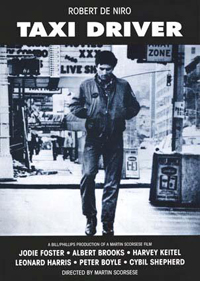Attention all movie buffs — this year 2016 marks the 40th anniversary of Taxi Driver. The cult classic by writer Paul Schrader and director Martin Scorsese premiered at the Cannes film festival in 1976, where it won the Palme d'Or award for best picture. Since then, it has been routinely listed as one of the greatest films ever made.
Last week I watched Taxi Driver for the first time. Of course, some aspects of it, like the clothes and its overt racism, are dated, but in general I found it amazing how powerful the movie still is. It reminded me of the importance of popular culture, and of how good art speaks to our human condition.
A young Robert De Niro (he was thirty-three at the time) plays a Vietnam Marine vet named Travis Bickle, an insomniac who drives a taxi in New York City from 6 PM to 6 AM. We didn't have the medical categories back then, but today we would say that he suffers from PTSD. He still wears his military jacket and boots. He lives alone, and records his dark thoughts in a diary.
Bickle is the embodiment of the alienated loner, even while surrounded by ten million people in one of the biggest cities in the world. He's a misanthrope who's disgusted at the urban decay he observes every night — porn shops, pimps, peep shows, drugs, and gangs. At the beginning of the film, he wishes out loud for "a real rain that would wipe all this scum off the earth."
"The film can be seen as a series of his failed attempts to connect," wrote Roger Ebert in his review, "every one of them hopelessly wrong." Bickle is lost in what Ebert calls his "utter aloneness."
He's obsessed with a girl who's way out of his league and whom he can never have, Betsy (Cybil Shepherd), "who appeared like an angel out of this filthy mess." He loses Betsy post haste after taking her to a Swedish porn movie. Angry over that failed human connection, he tries to save a 12-year-old prostitute named Iris (Jodie Foster). He fails there, too.
Bickle is a ticking time bomb. He confides to a fellow cabbie that his thoughts are turning violent: "I just wanna go out and really do something. I got some bad ideas in my head." He shaves his head into a Mohawk haircut, which even forty years later looks strangely contemporary and genuinely scary.
He buys not just one, but an entire cache of guns from a dealer named Easy Andy, then later, alone in his room, practices firing them while smack-talking to imagined victims in front of a mirror. He intends to assassinate a presidential candidate, but fails in that. He even fails at a suicide attempt.
The controversial and even unsatisfying ending of the movie — is it real or maybe a dream?, raises the question whether Bickle with his vigilante justice is a hero or a villain. Ebert calls him "the most alienating of movie heroes."
 |
My friend Scott Young of Culture Connection calls him a flawed anti-hero. He's living a strange mix of Dante's Inferno and Cervantes' Don Quixote, says Scott, in which the protagonist goes crazy and sets out to right all the wrongs in the world. Bickle is lost in the American Dream that's set in New York City — which in Taxi Driver is both a Utopian City and a Dystopian Nightmare where steam billows from the city sewers.
The musical score of Taxi Driver, observes one critic, is a "presentiment of catastrophe." The most famous line in the movie has passed into popular culture: "You talkin' to me?!" Even forty years later, Taxi Driver raises important questions about human alienation, loneliness, and violence through its brutal realism. The comparisons to our own epidemic of gun violence by alienated loners is unavoidable.
Ebert says that he watched Taxi Driver "dozens" of times, and that every time he did he still connected with it. Many people still feel the same way. In an interview that Schrader gave to The Guardian for the thirtieth anniversary of the film, we get a hint of why this is so true.
"At the time I wrote it [Taxi Driver] I was in a rather low and bad place," Schrader says. He was twenty-six at the time. "I had broken with Pauline [Kael], I had broken with my wife, I had broken with the woman I left my wife for, I had broken with the American Film Institute, and I was in debt." For several weeks, he drifted around LA, living and sleeping in his car, eating junk food, watching porn. Eventually, when his stomach began to hurt badly, he went to the hospital and discovered he had an ulcer.
"When I was talking to the nurse, I realized I hadn't spoken to anyone in weeks … that was when the metaphor of the taxi cab occurred to me. That is what I was: this person in an iron box, a coffin, floating round the city, but seemingly alone." He claims he wrote the script, which he dashed off in under a fortnight, as self-therapy, to "exorcise the evil I felt within me."
"The film holds up because it is true. It is true to who we were," Schrader says. "The reason it holds up is that it is the real deal. Scorsese, Bob (De Niro) and I were in that place at that time."
In his book Sculpting in Time (1986), the Russian filmmaker Andrei Tarkovsky says that "the allotted function of art is not, as is often assumed, to put across ideas, to propagate thoughts, to serve as an example. The aim of art is to prepare a person for death, to plough and harrow his soul, rendering it capable of turning to good."
Taxi Driver certainly "ploughs and harrows the soul," even forty years after the fact.
For Scott Young, see his Culture Connection.
For the Roger Ebert review, see here: http://www.rogerebert.com/reviews/great-movie-taxi-driver-1976
For the Guardian interview, see here: http://www.theguardian.com/film/2006/jul/06/features.geoffreymacnab



